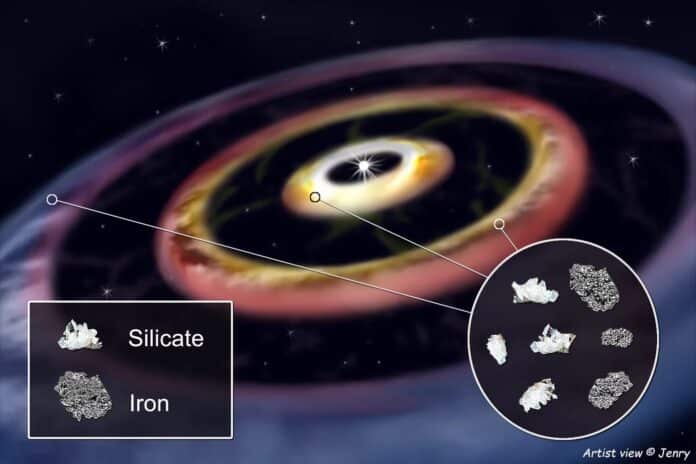In the rapidly advancing field of research on star and planet formation, scientists can now explore conditions in the surroundings of young stars and compare them to those present in the early Solar System. An international team of researchers, led by József Varga from the Konkoly Observatory in Budapest, Hungary, used the European Southern Observatory’s (ESO) Very Large Telescope Interferometer (VLTI) to achieve this feat.
The team detected a three-ringed structure in the planet nursery in a young star’s inner planet-forming disk. They observed the planet-forming disk of the young star HD 144432, approximately 500 light-years away.
The observed configuration indicates the formation of two Jupiter-mass planets within the gaps between the rings. Through detailed analysis, researchers found consistency with an abundance of solid iron grains complementing the dust composition. This suggests that the disk likely contains metals and minerals similar to those found in the terrestrial planets of our Solar System.
Roy van Boekel, a scientist at the Max Planck Institute for Astronomy (MPIA) in Heidelberg, Germany, said, “When studying the dust distribution in the disk’s innermost region, we detected for the first time a complex structure in which dust piles up in three concentric rings in such an environment.”
“That region corresponds to the zone where the rocky planets formed in the Solar System. Compared to the Solar System, the first ring around HD 144432 lies within Mercury’s orbit, and the second is close to Mars’s trajectory. Moreover, the third ring roughly corresponds to Jupiter’s orbit.”
Until now, astronomers mainly identified such configurations on larger scales, typically corresponding to regions beyond where Saturn orbits the Sun. Ring systems within the disks around young stars typically suggest the ongoing formation of planets within the gaps as they gather dust and gas. However, HD 144432 stands out as the first instance of such a complex ring system found near its host star.
This unique system is situated in a region abundant with dust, a fundamental component in forming rocky planets like Earth. Assuming the rings indicate the presence of two planets forming within the gaps, astronomers estimate their masses to be approximately Jupiter-sized.
Astronomers study the dust around a star, similar to how it’s done for Earth and other rocky planets. They found familiar materials like silicates (metal-silicon-oxygen compounds) and other minerals in Earth’s crust and mantle. There’s also a possibility of metallic iron, similar to what’s in Mercury and Earth’s cores. If confirmed, this discovery would be the first time iron is found in a disk where planets are forming.
The dust around HD 144432 can get very hot, up to about 1800 Kelvin (1500 degrees Celsius) close to the star, and milder, around 300 Kelvin (25 degrees Celsius), farther out. In the hot areas, minerals and iron can melt and recondense as crystals. On the other hand, carbon grains might not survive the heat and could exist as carbon monoxide or carbon dioxide gas. However, carbon could still be present in the solid particles in the cold outer disk, which this study couldn’t detect.
Having iron-rich and carbon-poor dust aligns with the conditions in our Solar System. Mercury and Earth, for example, are iron-rich planets, and Earth contains relatively little carbon.
Van Boekel said, “Iron-rich and carbon-poor dust would also fit nicely with the conditions in the Solar System. Mercury and Earth are iron-rich planets, while the Earth contains relatively little carbon. We think the HD 144432 disk may be very similar to the early Solar System that provided lots of iron to the rocky planets we know today.”
“Our study may pose as another example showing that the composition of our Solar System may be quite typical.”
The detailed findings were possible thanks to high-resolution observations provided by the Very Large Telescope Interferometer (VLTI). The VLTI combines the four 8.2-meter telescopes at ESO’s Paranal Observatory, offering a level of detail similar to what a telescope with a massive 200-meter diameter mirror could achieve.
Using three instruments covering a broad range of wavelengths from 1.6 to 13 micrometers (infrared light), the researchers obtained data with the help of MPIA’s contributions to GRAVITY and MATISSE instruments. MATISSE is designed to explore the regions where rocky planets form around young stars.
Thomas Henning, MPIA director and co-PI of the MATISSE instrument, said, “By looking at the inner regions of protoplanetary disks around stars, we aim to explore the origin of the various minerals contained in the disk – minerals that later will form the solid components of planets like the Earth.”
van Boekel said, “Besides the Solar System, HD 144432 appears to provide another example of planets forming in an iron-rich environment. However, the astronomers will not stop there. We still have a few promising candidates waiting for the VLTI to take a closer look at.”
“In earlier observations, the team discovered a number of disks around young stars that indicate configurations worth revisiting. However, they will reveal their detailed structure and chemistry using the latest VLTI instrumentation. Eventually, the astronomers may be able to clarify whether planets commonly form in iron-rich dusty disks close to their parent stars.”
Journal Reference:
- J. Varga, L. B. F. M. Waters, M. Hogerheijde, R. van Boekel et al. Mid-infrared evidence for iron-rich dust in the multi-ringed inner disk of HD 144432. Astronomy & Astrophysics (2024). DOI: 10.1051/0004-6361/202347535
